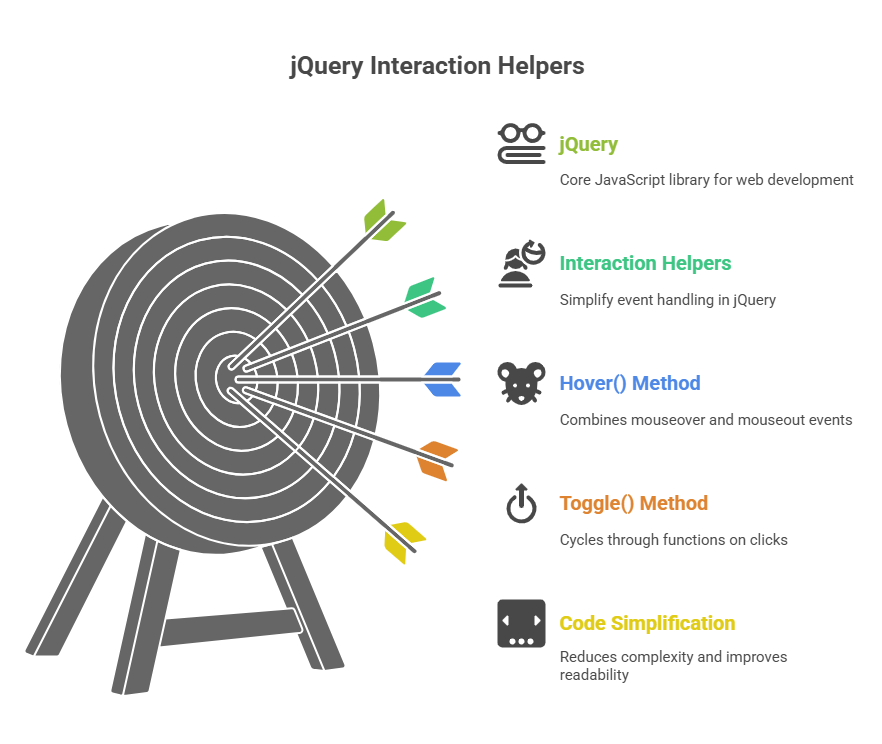Interaction Helpers in jQuery

By efficiently combining several related events into a single, more manageable function call, jQuery Interaction Helpers are specialised event functions created to streamline common event handling patterns. This technique abstracts away the complexity frequently involved with native JavaScript event detection and cross-browser inconsistencies, making your code clearer and more effective.
The point to two main tools for jQuery interaction:
Hover() Method: The hover() method combines mouseout (mouseleave) and mouseover (mouseenter) capabilities. Interactive features that display tooltips or change visual styles as a mouse pointer enters and leaves an area are beneficial.
- The hover() method accepts two callback functions as arguments: hover(over, out).
- Upon entering the matched element with the mouse pointer, the over function is triggered.
- As soon as the mouse pointer leaves the matching element, the out function is run.
- Known as a “Event Helper Method,” this technique “simulates hovering” and gives you access to a common task.
Toggle() Method: You can run distinct code blocks whenever an element is clicked by using the toggle() event helper. Instead of conditional logic (e.g., show/hide), toggle() switches states by toggling through a set of functions. The toggle() method accepts a string of functions as parameters: toggle(function1, function2, function3,…). It returns to the initial function when the list ends. Each click initiates the subsequent function in the sequence. This is not the same as the toggle() effect method, which makes items visible or invisible.
Benefits of Interaction Helpers
Code Simplification: Interaction helpers let developers “write less, do more” by condensing typical event pairings into single methods. Code that is more legible and succinct results from this.
Cross-Browser Compatibility: The underlying browser-specific variations in event models are handled by jQuery, which guarantees that the same code functions consistently across different browsers without requiring extra developer work.
Dynamic Web Pages: By making web pages responsive to user input and dynamic, these helpers improve the user experience by giving instant visual response.
Code Example
Let’s look at an example of code that uses the hover() method to dynamically alter text as a mouse pointer goes over and off a picture. This will demonstrate how to use an interaction helper.
<!DOCTYPE html>
<html>
<head>
<title>jQuery Hover Example</title>
<script src="https://ajax.googleapis.com/ajax/libs/jquery/3.6.0/jquery.min.js"></script>
<style>
body { font-family: Arial, sans-serif; text-align: center; margin-top: 50px; }
img { border: 2px solid #ccc; cursor: pointer; }
#text { margin-top: 20px; font-size: 18px; color: #333; }
</style>
<script>
$(document).ready(function(){
$('#img').hover(
function() {
$('#text').text('Mouse is now hovering OVER the image!');
$(this).css('border-color', 'blue');
},
function() {
$('#text').text('Mouse has left the image.');
$(this).css('border-color', '#ccc');
}
);
});
</script>
</head>
<body>
<img src="https://via.placeholder.com/150" id="img" alt="Hover Image">
<div id="text">Hover your mouse over the image above.</div>
</body>
</html>Output:
Hover Image
Mouse has left the image.Explanation of the Code Example
$(document).ready(function(){ … });: This simple jQuery approach runs all jQuery code in this block only after the HTML document (DOM) is loaded and ready for interaction. This stops mistakes from happening if jQuery attempts to work with unrenderable items.
$(‘#myImage’): This is a selector in jQuery. This code selects the HTML element with the id attribute “myImage” using $ (alias for jQuery()).
.hover(function() { … }, function() { … });: This is the use of the hover() interaction helper. Its arguments are two anonymous functions:
- The callback for over is the first function. This function runs the code when the mouse pointer is over the picture (#myImage).
- Using the.text() method, the text in the #displayText element is changed to “Mouse is now hovering OVER the image!” in this example. The.css() method is used to modify the image’s border colour to blue.
- The callback for out is the second function. Here is the code that executes when the mouse pointer leaves the picture. It changes the border colour of the image to grey and modifies the text in #displayText to read “Mouse has left the image.”
.text(‘…’) and .css(‘property’, ‘value’): Both.text(‘…’) and.css(‘property’, ‘value’) require Examples of jQuery methods that change the styling and content of specific HTML elements are shown below.
Hover() provides dynamic visual feedback without requiring complicated conditional statements or separate event listeners for mouseenter and mouseleave, as this example demonstrates. It does this by handling both mouse entry and exit events with a single, understandable function call.
